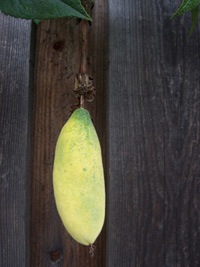 The folks over at The Human Flower Project are trying to identify this fruit, which apparently can be found in abundance in Oakland, California. They think they’ve pinned it down to Passiflora mollissima, but maybe you know better. I grew P. mollissima once, in an unheated greenhouse, and although it flowered well enough it didn’t set fruit. So although the flowers look familiar, the fruit remains a mystery. One of the reasons I wanted to grow it was to do this:
The folks over at The Human Flower Project are trying to identify this fruit, which apparently can be found in abundance in Oakland, California. They think they’ve pinned it down to Passiflora mollissima, but maybe you know better. I grew P. mollissima once, in an unheated greenhouse, and although it flowered well enough it didn’t set fruit. So although the flowers look familiar, the fruit remains a mystery. One of the reasons I wanted to grow it was to do this:
“The pulp is eaten out-of-hand or is strained for its juice, which is not consumed alone but employed in refreshing mixed cold beverages. In Bolivia, the juice, combined with aguardiente and sugar, is served as a pre-dinner cocktail. Colombians strain out the seeds and serve the pulp with milk and sugar, or use it in gelatin desserts. In Ecuador, the pulp is made into ice cream.â€
Those treats remain a fond hope. I had a quick look to see whether the juice or pulp might be available commercially in Europe, but couldn’t find anything. Is it?
 The folks over at
The folks over at